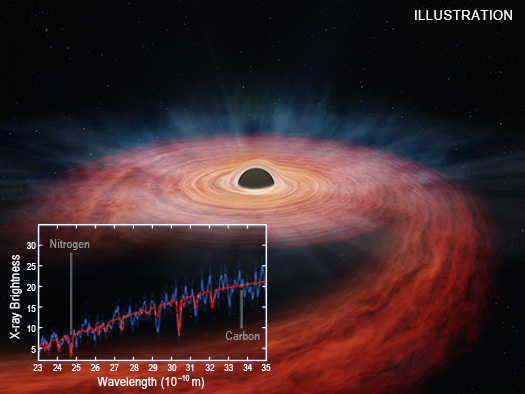Chandra Studies a Moderately Massive Star Destroyed by a Giant Black Hole In Another Galaxy
We are happy to welcome Dr. Brenna Mockler as our guest blogger. Brenna is a postdoctoral fellow at Carnegie Observatories in Pasadena. Her research is primarily on high-energy transients, with a focus on learning about the supermassive black holes in the centers of galaxies and the environments they live in. Prior to her current position, she was a UC Chancellor's fellow at UCLA. She earned her PhD in Astronomy & Astrophysics from the University of California at Santa Cruz in 2022, and a bachelor's degree in Physics from Cornell University in 2016.
At the center of most large galaxies lies a supermassive black hole, larger than our solar system and millions to billions of times more massive than our Sun. These giant black holes influence the evolution of the entire galaxy — for example, they are thought to regulate star formation and their mass is strongly correlated with the mass of the galaxy. Supermassive black holes live in ‘galactic nuclei’ — dense, extreme environments, packed with thousands to millions of times the density of stars that we see in our own night sky.
While we can estimate the bulk characteristics of these nuclei, it is challenging to measure the individual components that make them up. Because there are so many stars packed so closely together, it is very difficult to pick out the unique characteristics of each star. Imagine you are out in the suburbs staring at a distant city skyline — you can tell there is a lot of light, but you can’t pick out the details of each individual lamppost and billboard. However, occasionally one of these stars will pass too close to the supermassive black hole at the center, and get ripped apart by the tidal forces from the black hole in a “tidal disruption event” (TDE).
These TDEs are a more dramatic example of the same physics that produces ocean tides on earth (if we replaced the Sun with a massive black hole and the Earth with a star). After the star is disrupted, the gas that made it up will orbit the black hole and eventually fall onto it, producing a flare that is so bright it outshines the rest of the galaxy. When this happens, we can study both the properties of the black hole and the star that was disrupted.
One of the best studied TDEs is ASASSN-14li, which was discovered by the ASASSN ( “All-Sky Automated Survey for Supernovae”) transient survey using a network of optical telescopes. The astronomy community then followed up the initial detection of the transient with observations at many different wavelengths.
One of the things that makes ASASSN-14li unique is the fact that we have detailed X-ray observations from NASA’s Chandra X-ray Observatory and ESA’s XMM-Newton of this event. X-rays from TDEs are most likely associated with the processes of gas falling onto the black hole. However, in most optically detected TDEs, it seems like the X-rays are either very faint or obscured by gas from the disrupted star. In this case we got lucky, and we have detailed X-ray observations that have not only allowed astronomers to constrain the properties of the disk of gas surrounding and feeding the black hole, but have allowed us in this work to constrain the composition of the gas itself.
In this work, we used X-ray observations from Chandra and XMM-Newton to constrain the amount of Nitrogen to Carbon in the gas surrounding the black hole that likely originated from the disrupted star. The ratio of Nitrogen to Carbon in the interior of a star is very dependent on its mass and evolutionary stage. Stars above ~1-2 times the mass of the Sun will start fusing Carbon, Nitrogen and Oxygen in their cores as part of the `CNO’ cycle. The CNO process produces a significant fraction of the energy (and therefore light that we see) for these stars.
Illustration of ASASSN-14li with X-ray Spectrum from Chandra (Illustration Credit: NASA/CXC/M.Weiss)
A side effect of this process is that it increases the amount of Nitrogen compared to Carbon in the stellar interiors. Because of this, the ratio of Nitrogen to Carbon increases for stars that spend a larger fraction of their lifetime on the CNO cycle, and is higher for more massive and older stars. By constraining the ratio of Nitrogen to Carbon using X-rays, we were able to determine that the disrupted star must have been producing CNO cycle elements for some time, and was likely originally at least three solar masses.
While three solar masses doesn’t seem like a very massive star compared to the masses of stars that explode in supernovae, we expect the stars that become TDEs to be drawn almost randomly from the general stellar population in the galactic center. Most stars are predicted to be born at small masses — the median mass is expected to be less than half the mass of our Sun, and stars above the mass of our Sun are quite uncommon.
Together with other recent work that uses UV data to constrain high Nitrogen to Carbon ratios in two other TDEs (as well as placing initial constraints on ASASSN-14li, see Yang et al. 2017), we are observing a trend of stars getting disrupted that are much more massive than expected from the general stellar population. At this point it is unclear if we are seeing something unique about the stellar populations in the very centers of galaxies, or if there are intricacies related to the disruption process that are biasing us towards disruptions of these types of stars. Either way, we are learning about stars at the very centers of other galaxies on size scales that are difficult to observe outside of our own galactic neighborhood.
Please note this is a moderated blog. No pornography, spam, profanity or discriminatory remarks are allowed. No personal attacks are allowed. Users should stay on topic to keep it relevant for the readers.
Read the privacy statement


